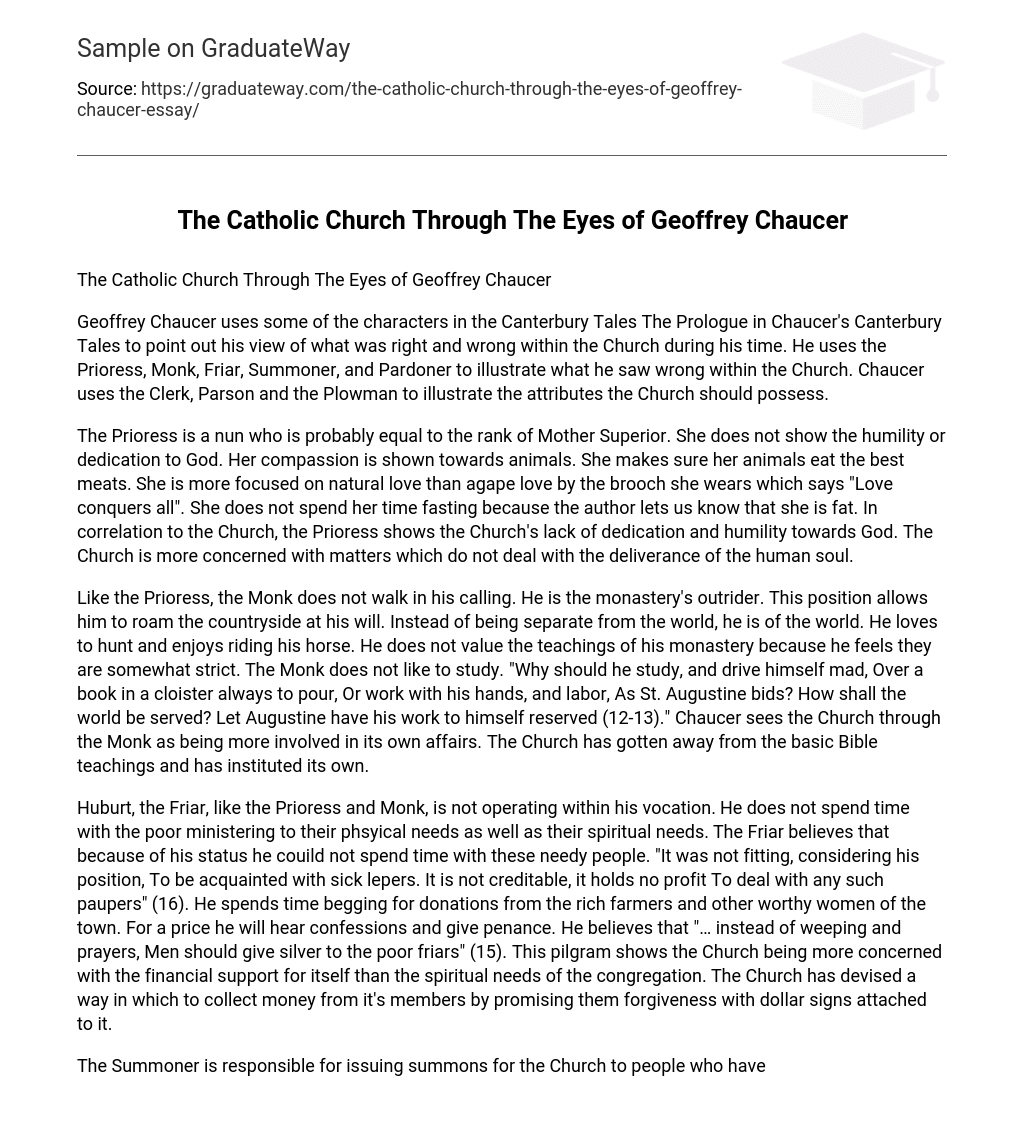The Catholic Church Through The Eyes of Geoffrey Chaucer
Geoffrey Chaucer uses some of the characters in the Canterbury Tales The Prologue in Chaucer’s Canterbury Tales to point out his view of what was right and wrong within the Church during his time. He uses the Prioress, Monk, Friar, Summoner, and Pardoner to illustrate what he saw wrong within the Church. Chaucer uses the Clerk, Parson and the Plowman to illustrate the attributes the Church should possess.
Like the Prioress, the Monk does not walk in his calling. He is the monastery’s outrider. This position allows him to roam the countryside at his will. Instead of being separate from the world, he is of the world. He loves to hunt and enjoys riding his horse. He does not value the teachings of his monastery because he feels they are somewhat strict. The Monk does not like to study. “Why should he study, and drive himself mad, Over a book in a cloister always to pour, Or work with his hands, and labor, As St. Augustine bids? How shall the world be served? Let Augustine have his work to himself reserved (12-13).” Chaucer sees the Church through the Monk as being more involved in its own affairs. The Church has gotten away from the basic Bible teachings and has instituted its own.
Huburt, the Friar, like the Prioress and Monk, is not operating within his vocation. He does not spend time with the poor ministering to their phsyical needs as well as their spiritual needs. The Friar believes that because of his status he couild not spend time with these needy people. “It was not fitting, considering his position, To be acquainted with sick lepers. It is not creditable, it holds no profit To deal with any such paupers” (16). He spends time begging for donations from the rich farmers and other worthy women of the town. For a price he will hear confessions and give penance. He believes that “… instead of weeping and prayers, Men should give silver to the poor friars” (15). This pilgram shows the Church being more concerned with the financial support for itself than the spiritual needs of the congregation. The Church has devised a way in which to collect money from it’s members by promising them forgiveness with dollar signs attached to it.
The Summoner is responsible for issuing summons for the Church to people who have violated Church doctrine. His position is interesting because he is handing out summons for people to appear before the Church when he himself is living in direct violation of Church doctrine. The Church seems to see what is wrong with everyone else but cannot focus on it’s own violations of the doctrine taught in the Bible.
The Pardoner is the most corrupt pilgram. He provides paper indulges for a price. These indulges are part of the scam the Pardoner is running. He also offers junk for sale which he says were relics of the saints. The Church has developed another mechanism for making money. It uses the selling of crosses, statues, and other trinkets which are supposed to remind us of what Christ has done for us. If these items were really to remind us of what Christ did for us they would be free, since Christ gave his life freely.
The Clerk is the first pilgram Chaucer birngs into the script which has some godly attributes. He spends time in prayer and fasting because the narrator lets us know that he “…wasn’t exactly fat, …”(19) and “…busily prayed for souls” (20). He only spoke when it was necessary and when he did speak people listened to him. “And that was said with care and respect,… Resonant with moral virtue was his speech,” (20). The Church lacks this characteristic based on the corruption which Chaucer points out in the pilgrams listed above.
The Parson is the ideal clergyman. He places his congregation above himself. He visits each member of his parish no matter what the weather. He was rich in holy thought, patient in adversity and doesn’t nag his parish for contributions. He is truly a shepherd in word and in deed. “That first he practiced, and afterwards he preached;” (32). The Church needs to be like the Parson, a doer of the word instead of a hearer only.
The Plowman is the brother of the Parson. He is a good man, also. He possesses humility. He lived in “…peace and perfect charity”(34). He did not have any problems with doing the jobs no one else wanted to do. The Church is low on the attribute of humility. The Church wants to be the center of attention instead of focusing on the needs of the people.
Chaucer’s Canterbury Tales The Prologue points out the corruption within the Catholic Church.





